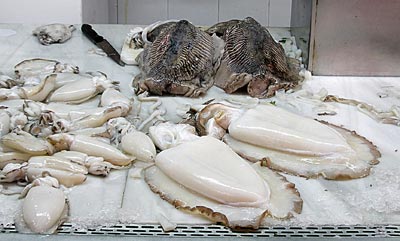Wels or sheetfish. A type of catfish that can grow up to 5 m (16 ft) in the wild and is Europe's largest freshwater. It is found in the Rhine River in Germany eastwards to the Black and Caspian Seas. The elongated wels body consists of a powerful forebody and a laterally greatly compressed tail shaft; the prominent anal fin merges with the caudal fin. This fish, with its calm undulating tail movements normally has its long pair of upper jaw barbels pointing straight forward, while the four smaller barbels of the lower lip hang down. The dorsal fin, consisting of just four rays, seems small for such a powerful animal. In the wild they have been known to eat ducks where they rush up behind them at night, sucking them into their mouths with a vortex motion. In their native habitat they feed on other fishes mainly eels, burbot, tench and roach, but it also takes water voles.

Cuttlefish. A cephalopod related to the squid. The flesh of the cuttlefish is meatier and has a more complex flavour. Both the cuttlefish and the squid have an ink sac. The liquid it contains can be used in the cooking process but it should be added towards the end or it will coagulate. The ink of the cuttlefish is generally felt to be richer, denser, smoother than that of the squid.

A highly spiced sausage pâté flavoured with garlic and paprika and almost like a spread, from Mallorca in the Balearics. Bears no relation to Italian soppressata.
Sofrito. Onions fried slowly in olive oil with tomato and garlic - the basis of many dishes in Catalonia.
Some sources show this to be the shortfin mako shark, but I think it is more likely to be the porbeagle or mackerel shark. A member of the shark family common in the Atlantic. It grows to 4 meters (13 ft) in length. It has good flavour and texture and is grilled in the form of steaks.